At first sight, there’s nothing extraordinary about Alice Fox’s allotment in West Yorkshire, England. In fact, her garden community neighbors are “mostly oblivious” to the magic she weaves there. The addition of a flax crop may have been a novelty when she first rented the plot, but the size and layout of the land, sheds, and greenhouse seem pretty standard—until you look closer.
Peek through the window of the main shed and your eyes will be drawn to a wonderful organized jumble of plant pots, trays, tools, jars of homemade botanical inks, sketches, scribbles, samples, fragments of ceramics, wire, plastic, and other unearthed objects, as well as an ever-changing assortment of plant fibers in various stages of drying and hand-processing. This is where Fox’s uniquely beautiful and thought-provoking textile art begins to take form.
Alice took on Plot 105 in Autumn 2017 when she started her practice-based master’s program to explore ways to achieve greater self-sufficiency in her art. Although she’d had a share in an allotment previously, with a young family, she never really had the time to give to it: “The only way I could justify it was to make it part of my work,” she says.
In 2020, Alice self-published the story of her relationship with her allotment Plot 105 and how her engagement with the site has unfolded since taking it on. Today, her book sits in a shed, alongside the encyclopedia of gardening left by the previous tenant. Looking back, she acknowledges that her year of research “marked a fundamental shift in how I source my materials. It allowed me to grow as a gardener, giving a particular focus. It provides a space to be amongst nature, get my hands in the soil, and think while working there.”
We met Alice in West Yorkshire this summer to learn more about her allotment, her garden, and home studio, and the evolution of her sustainable creative practice that’s deeply embedded in land and place. Let’s dig deeper:
Photography courtesy of Alice Fox. Featured image (above) by Carolyn Mendelsohn.
Above: In keeping with Alice’s local approach and quest for self-sufficiency, Plot 105 is a working garden providing fresh home-grown, seasonal produce. Few changes have been made to the overall structure of the plot, except for planting a couple of trees and some fruit bushes. Most of the growing beds are used for vegetables, and there are about 12 fruit trees, taking up approximately one quarter of the space. Photograph by Carolyn Mendelsohn.
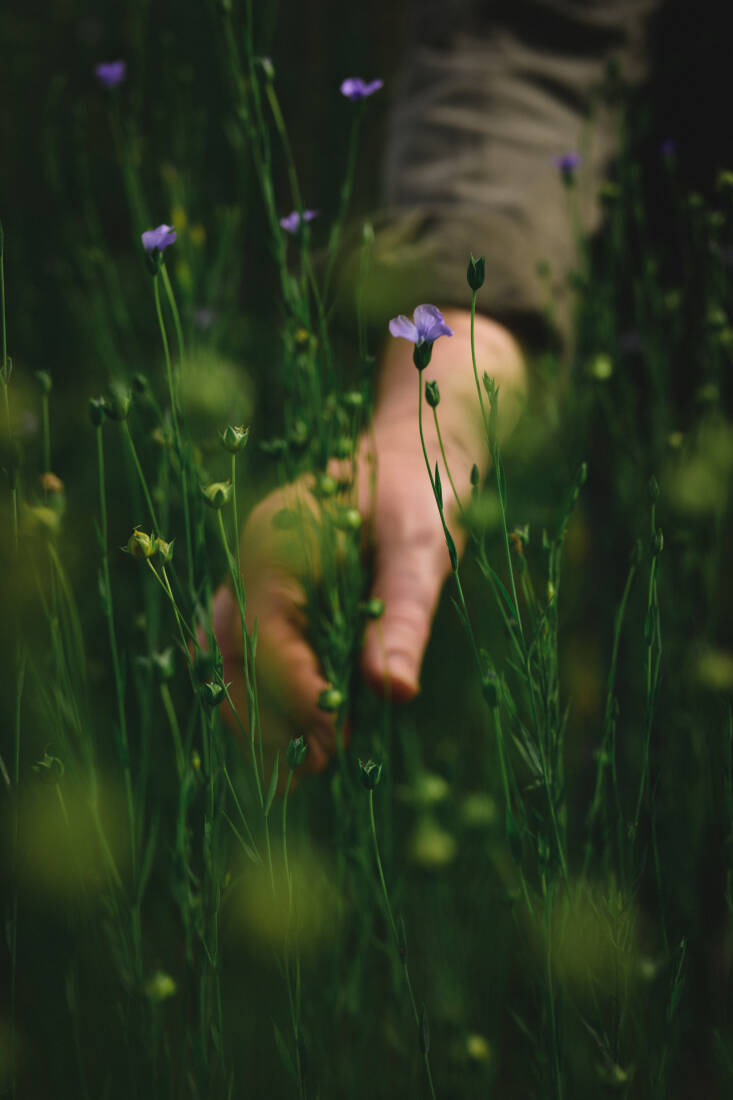 Above: Alice introduced a flax crop in 2017 and, since then, has learned a lot about this wonderful plant through growing and processing. Recently, she applied her knowledge to projects in new places, such as Kestle Barton in Cornwall. This experience culminated in her flax-focused exhibit Flaxen, shown at Northern Ireland Linen Biennale. Photograph by Carolyn Mendelsohn.
Above: Alice introduced a flax crop in 2017 and, since then, has learned a lot about this wonderful plant through growing and processing. Recently, she applied her knowledge to projects in new places, such as Kestle Barton in Cornwall. This experience culminated in her flax-focused exhibit Flaxen, shown at Northern Ireland Linen Biennale. Photograph by Carolyn Mendelsohn.
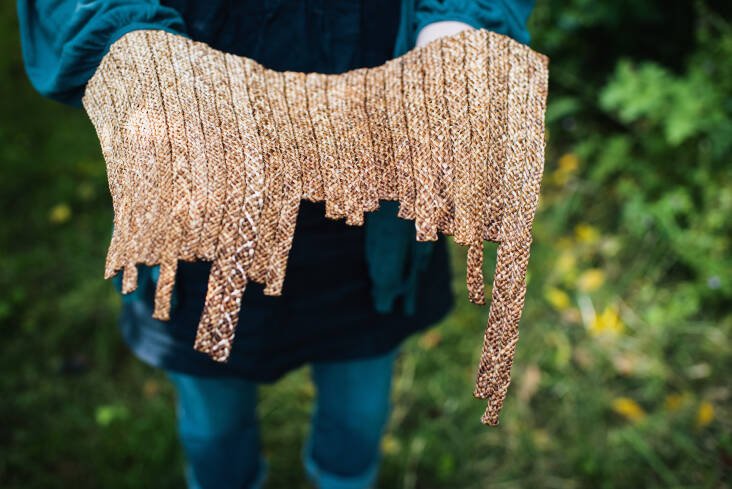 Above: “My approach to materials and commitment to working just with what is on site pushes me to be experimental,” explains Alice. Her “frugal creativity” leads her to explore the edges of her plot, where she gathers dandelions, nettles, brambles, and bindweed growing wild. This braided and stitched strip cloth was made entirely from dandelion stems gathered on the allotment. Photograph by Sarah Mason.
Above: “My approach to materials and commitment to working just with what is on site pushes me to be experimental,” explains Alice. Her “frugal creativity” leads her to explore the edges of her plot, where she gathers dandelions, nettles, brambles, and bindweed growing wild. This braided and stitched strip cloth was made entirely from dandelion stems gathered on the allotment. Photograph by Sarah Mason.
 Above: Alice’s process-led practice allows her to explore the potential of various grown, gathered, and found materials throughout the seasons. Every spring, she has a crush on dandelion stems, which “have a slump to them when woven or braided, so they are more suitable for work that will drape somehow.” In this “Random Weave” piece, the stems were gathered, dried, and manipulated to form cordage and then freely interwoven. Photograph by Alice Fox.
Above: Alice’s process-led practice allows her to explore the potential of various grown, gathered, and found materials throughout the seasons. Every spring, she has a crush on dandelion stems, which “have a slump to them when woven or braided, so they are more suitable for work that will drape somehow.” In this “Random Weave” piece, the stems were gathered, dried, and manipulated to form cordage and then freely interwoven. Photograph by Alice Fox.
 Above: There are three sheds in various states (one roofless and not really in use) and a small greenhouse on the allotment. The main shed is part greenhouse. Alice uses this spot for drying materials, growing seedlings, and storing her tools. Photograph by Alice Fox.
Above: There are three sheds in various states (one roofless and not really in use) and a small greenhouse on the allotment. The main shed is part greenhouse. Alice uses this spot for drying materials, growing seedlings, and storing her tools. Photograph by Alice Fox.
 Above: Having tested, sampled, and explored many plant fibers since taking over the plot, Alice has finally whittled down her selection to “a palette of materials that are more abundant and good to work with.” The specific qualities of these different materials lead her into different types of work, which suits Alice perfectly: “I like to not be pinned down by one set of media or techniques.” Bindweed, for example, holds a shape well, so its properties lend themselves to more structural work, as shown here, paired with apple wood prunings from the plot. Photograph by David Lindsay.
Above: Having tested, sampled, and explored many plant fibers since taking over the plot, Alice has finally whittled down her selection to “a palette of materials that are more abundant and good to work with.” The specific qualities of these different materials lead her into different types of work, which suits Alice perfectly: “I like to not be pinned down by one set of media or techniques.” Bindweed, for example, holds a shape well, so its properties lend themselves to more structural work, as shown here, paired with apple wood prunings from the plot. Photograph by David Lindsay.
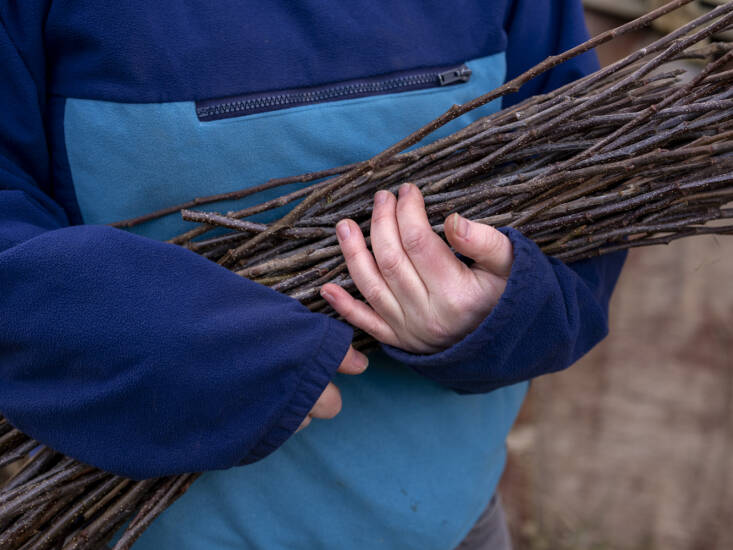 Above: Everything Alice grows, gathers, or forages is imbued with a sense of place—memories that make her handcrafted pieces all the more meaningful. Pruning apple trees in winter in the company of blackbirds brings great satisfaction: It prepares the trees for their next growing season and also provides new material to use in her work. Nothing is wasted—what’s not used becomes kindling and firewood. Photograph by Tessa Bunney.
Above: Everything Alice grows, gathers, or forages is imbued with a sense of place—memories that make her handcrafted pieces all the more meaningful. Pruning apple trees in winter in the company of blackbirds brings great satisfaction: It prepares the trees for their next growing season and also provides new material to use in her work. Nothing is wasted—what’s not used becomes kindling and firewood. Photograph by Tessa Bunney.
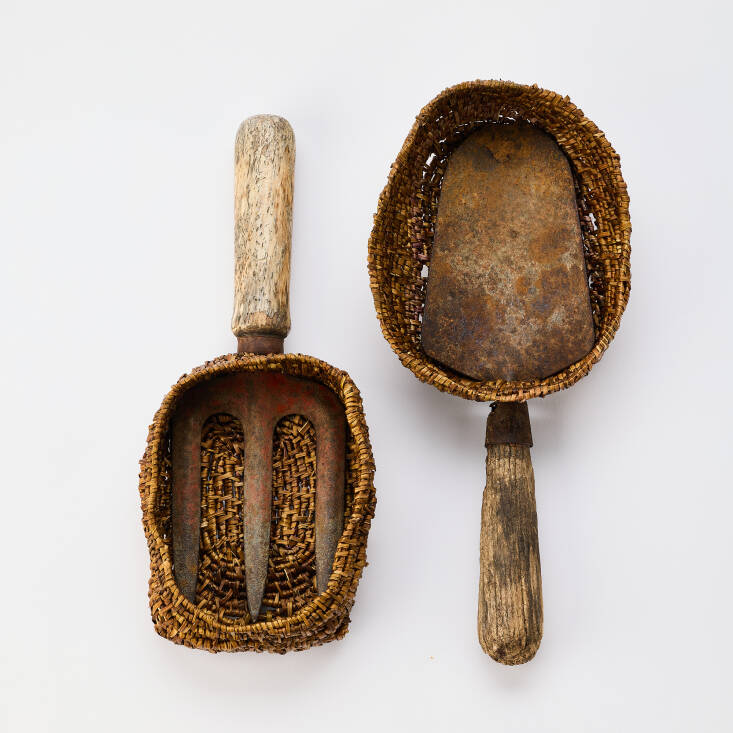 Above: Over the years Alice has unearthed a collection of “allotment archeology” on the plot, found fragments of metal, plastic, pottery, and other discarded objects, which she playfully combines with her woven art to create sculptural art pieces. Hybrid 8 and 9 pairs a rusty fork and trowel with bindweed. Photograph by David Lindsay.
Above: Over the years Alice has unearthed a collection of “allotment archeology” on the plot, found fragments of metal, plastic, pottery, and other discarded objects, which she playfully combines with her woven art to create sculptural art pieces. Hybrid 8 and 9 pairs a rusty fork and trowel with bindweed. Photograph by David Lindsay.
 Above: An example of one of Alice’s studio walls and desks, showing the beauty and scope of her practice-based research on Plot 105: making cordages, weaving, sculpting, botanical ink-making, drawing, inventing with found objects, photography, leaf-stitching, book-making, botanical contact-printing… Photograph by Alice Fox.
Above: An example of one of Alice’s studio walls and desks, showing the beauty and scope of her practice-based research on Plot 105: making cordages, weaving, sculpting, botanical ink-making, drawing, inventing with found objects, photography, leaf-stitching, book-making, botanical contact-printing… Photograph by Alice Fox.
 Above: Alice divides her time between her main shed ‘studio’ and the allotment, and her home in Saltaire, West Yorkshire, where she has an attic studio. She tells us that her large tapestry loom is in the living room and she often works on the kitchen table: “I work wherever I need to. It would be good to have a dedicated space (I dream of outbuildings), but this integrated approach is practical for now.” Photograph by Alice Fox
Above: Alice divides her time between her main shed ‘studio’ and the allotment, and her home in Saltaire, West Yorkshire, where she has an attic studio. She tells us that her large tapestry loom is in the living room and she often works on the kitchen table: “I work wherever I need to. It would be good to have a dedicated space (I dream of outbuildings), but this integrated approach is practical for now.” Photograph by Alice Fox
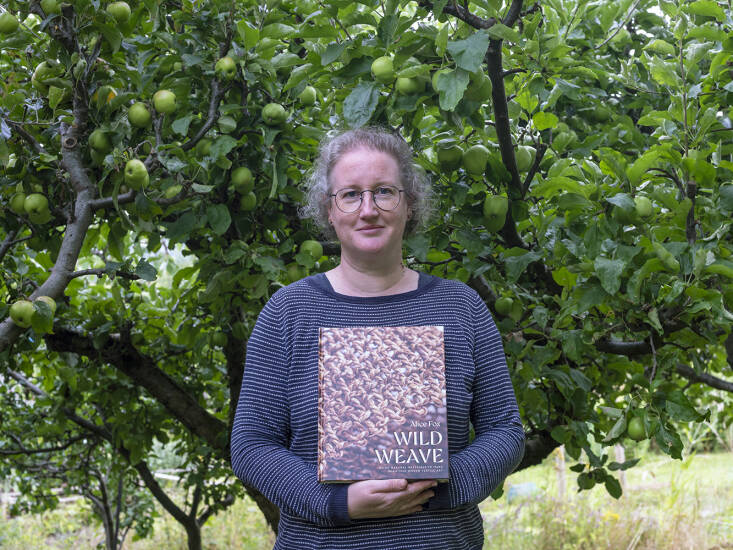 Above: Alice’s latest book, Wild Weave: Making Natural Materials to Make Beautiful Woven Textile Art, was released last month and is her third book to be published by Batsford. “It encourages an open-minded and playful approach to creating beautiful and innovative woven artworks” and “promotes the idea of engaging with simple tools and technology, as well as making use of locally sourced and unconventional materials.” Photograph by Tessa Bunney.
Above: Alice’s latest book, Wild Weave: Making Natural Materials to Make Beautiful Woven Textile Art, was released last month and is her third book to be published by Batsford. “It encourages an open-minded and playful approach to creating beautiful and innovative woven artworks” and “promotes the idea of engaging with simple tools and technology, as well as making use of locally sourced and unconventional materials.” Photograph by Tessa Bunney.
For more information about Alice and her creative practice, visit here.
See also:



